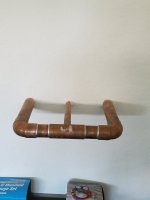Jason M Law
New Member
Hello all! I am a DIYer trying to save my money on install costs for a water softening system (and potentially filtration system) looking for a good amount of help on both selection of a system and some tips on materials/tools I'll need. I noticed the Fleck because of its price (Amazon) and through research found the Genesis which touts a much higher efficiency and cost savings over time. Consensus seems to be that it's mostly marketing spin that upflow systems are dramatically more efficient than downflow on this forum. So is it fair to say a properly configured upflow system vs a properly configured downflow system isn't likely to be 74% salt savings and 60% water savings or anywhere near that? If there are other upflow systems that will mean more savings over time, I would be willing to invest more up front.
I live in a 3.5 bath home (extra sink/dishwasher in an attached mother in law suite) with a total of 4 people living inside averaging 5500 gallons per month. I also want to make sure the system is flexible if I want to sell to a family with kids and in laws which could reasonably be 6-8. 6 still seems a reasonable max to plan the system for. The water is very hard where I am and my understanding is that it's near 20 gpG in my location. Hach 5B test kit will arrive tomorrow so I can be more precise on that!
The water is also heavily chlorinated/smelly so I was looking at carbon filters so any advice on the value/benefit here is appreciated. I noticed in some posts its not recommended but I'd be curious to know why since I am pretty much clueless when it comes to water quality/treatment.
Lastly, I read (mostly through amazon reviews) that pre-filtering with sediment filters (one at 50 microns one at 20 microns) will elongate or at least prevent early failure of the follow-on filtration/softening systems. Is that a worthwhile measure and generally true statement?
Thank you in advance!
I live in a 3.5 bath home (extra sink/dishwasher in an attached mother in law suite) with a total of 4 people living inside averaging 5500 gallons per month. I also want to make sure the system is flexible if I want to sell to a family with kids and in laws which could reasonably be 6-8. 6 still seems a reasonable max to plan the system for. The water is very hard where I am and my understanding is that it's near 20 gpG in my location. Hach 5B test kit will arrive tomorrow so I can be more precise on that!
The water is also heavily chlorinated/smelly so I was looking at carbon filters so any advice on the value/benefit here is appreciated. I noticed in some posts its not recommended but I'd be curious to know why since I am pretty much clueless when it comes to water quality/treatment.
Lastly, I read (mostly through amazon reviews) that pre-filtering with sediment filters (one at 50 microns one at 20 microns) will elongate or at least prevent early failure of the follow-on filtration/softening systems. Is that a worthwhile measure and generally true statement?
Thank you in advance!
Attachments
Last edited:


